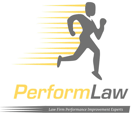Law firms typically have weak demand forecasting and management systems, causing them to react too intensely to current events. Common reactions include overhiring or cutting staff in response to changes in clients or case flow. These reactions compound the problems they intend to solve.
Innovation is difficult in law firm environments. Lawyers spend their time focusing on cases and obtaining the best results for their clients. They have little time for anything else and a low tolerance for short-term disruptions in workflow. Many resent what they see as unnecessary micromanagement and have a natural resistance to creating internal performance management systems.
Pushing through those impulses and building systems to manage demand and production will lead to better client satisfaction, morale, better case outcomes, and higher profitability.
Focusing on performance at the demand stage is essential to achieving these outcomes.
One challenge is finding the right applications for the legal environment. It is not likely that a firm will find one application that does time, billing and accounting, demand management, production (case) management, marketing, and CRM in one platform. More often than not, firms need two or three applications to handle all of their information needs.
We recommend the use of project or practice management software to keep track of workload and capacity, as well as demand trends. Law firms keep a lot of data in these systems that can be put to use to assess current and future caseloads.
Cost-effective, off-the-shelf applications
Off-the-shelf database applications like Airtable, and project management software like Teamwork or Monday.com have advanced task management capabilities that law firms can adapt to the legal environment.
These systems allow for detailed task and hour allocations and allow users to build out reports and dashboard visualizations that simplify demand (who and how much gets in) and case (production) management. For the motivated, it is not too difficult to learn and adapt these systems to almost any environment.
Custom legal applications
Several legal industry-specific applications exist that can also help. For example, Litify and Nulaw are built on a customizable platform but also include prebuilt case management features.
Firms that embrace a technology-driven project management approach can use workload planners and task schedulers to manage staffing levels and assess capacity for additional work. By assigning tasks to users along with a time estimate and a deadline, managers can monitor current and upcoming workloads on a more granular level.
Practice Management Applications
While it may not always be possible to project accurate task timelines, especially in litigation matters, it is possible to create the basic steps and assignments at the outset and adjust later. For example, a general outline of a case could give the case manager the ability to allocate tasks and time to an associate or a paralegal a few weeks out. If this is done in all cases across the firm, management will get a good picture of how busy everyone is currently and how much capacity they may have for additional work.
Practice management applications like ZolaSuite, Centerbase or Actionstep are fully integrated with case management, document management, and accounting functionalities. They are less sophisticated in their project management capabilities, however, if used properly, they can provide basic information on workloads and demand. These systems also offer a degree of integration with other critical management applications.
Practice Management Applications
To ensure system reports are informative, it is critical to implement policies to capture the right data. In other words, users need to consistently fill out form fields, track time, and update matters in the system. This will allow for powerful reporting that simplifies workload monitoring and forecasts future productivity, including files opened/closed per month, average time spent on a matter, staffing ratios, and more.
For more information on operational reports and KPIs, check out our article on Financial and Operational KPIs your firm can track right now: KPIs ARTICLE
Our hope is that you can think about demand management separately from production management. Demand management requires strong strategic vision and adherence to the firm's core values. More is not always better and can crowd out better opportunities.
Software mentioned in this article:
- Airtable
- Teamwork
- Monday.com
- Litify
- Nulaw
- ZolaSuite
- Centerbase
- Actionstep

PerformLaw works with clients to improve performance in systems and processes, profitability, organizational development, and strategic planning. Many of our clients have recognized the need to modernize their systems and processes and embrace the new ways of getting work done.
If you feel your firm needs an update or a new plan altogether, we can help. Set up a call to learn more.
.webp?width=124&height=108&name=PerformLaw_Logo_Experts3%20(1).webp)

